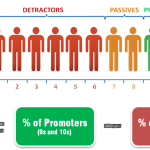How to Implement a Customer Satisfaction Survey
Customer satisfaction is the backbone of any successful business. If you don’t know what your clients are thinking, they may leave due to dissatisfaction without you ever being aware of the issues.
Retaining existing clients is significantly more cost-effective than constantly trying to attract new ones. A well-structured customer satisfaction survey allows you to gather actionable insights that help improve customer relationships, refine business processes, and enhance service delivery.
Understanding the Importance of Customer Feedback
Trust and integrity are major factors in today’s online world. Google reviews and online testimonials provide essential social proof and help build brand trust, influencing potential customers’ decisions. Ensuring that your customers feel valued and heard through surveys strengthens this trust and encourages positive engagement with your brand.
By conducting a structured survey, businesses can identify strengths, pinpoint areas for improvement, and demonstrate a commitment to continuous growth and customer care.
Structuring Your Survey Questions: Best Practices
The effectiveness of a survey is largely determined by the structure and wording of its questions. Here are some key best practices:
• Keep it concise and focused: Surveys should be short and relevant to maximise completion rates.
• Use clear and neutral wording: Avoid leading or biased questions that might influence responses.
• Mix question types: Use a combination of multiple-choice, rating scales (e.g., Likert scale), and open-ended questions to gather both quantitative and qualitative data.
• Group similar topics together: Organise questions in a logical flow, such as: Brand Perception (“How likely are you to recommend our brand to others?”), Product/Service Experience (“How satisfied are you with the quality of our product/service?”), Customer Support (“How effective was our support team in resolving your issue?”), Overall Satisfaction & Suggestions (“What improvements would you like to see?”)
• Avoid jargon and technical language: Keep questions simple and easy to understand.
• Provide an option for anonymity: Confidential surveys often yield more honest feedback.
Best-of-Breed Online Survey Platforms
Using best-of-breed survey tools ensures that your survey is well-structured, professional, and capable of delivering high-quality results. These tools provide key benefits such as automation, built-in analytics, customisation, and integration with existing business processes.
A well-designed survey tool improves the response rate by offering a seamless and engaging experience for respondents. Additionally, these platforms provide detailed reporting and analysis features that make it easier to extract actionable insights, helping businesses make data-driven decisions based on reliable customer feedback.
Structuring and Sending Your Survey
To maximise engagement and response rates, consider the following strategies when structuring and distributing your survey:
• Grouping questions logically: Start with general questions and gradually move towards specific ones.
• Keeping it confidential (if necessary): Assure respondents that their answers will remain anonymous to encourage honest feedback.
• Avoiding bad question design: Stay away from double-barreled questions (e.g., “Was our service quick and efficient?”) as they can confuse respondents.
• Choosing the right distribution channel: Send the survey via professional email marketing tools rather than from a staff member’s personal email address.
• Setting an appropriate deadline: Give respondents enough time but include a gentle reminder sequence to encourage participation.
Engaging an Independent Third Party for Survey Management
To ensure unbiased and high-quality feedback, businesses should consider working with an independent brand agency like rev™ Branding. Agencies bring expertise in marketing and communications, ensuring:
• Expertly crafted questions that maximise response rates and elicit meaningful feedback.
• Professional survey distribution to maintain credibility and impartiality.
• Strategic reminder sequences that nudge non-respondents without overwhelming them.
• Comprehensive feedback analysis – Agencies consolidate responses into actionable reports, making insights easier to digest and act upon.
• Clear communication of results – Agencies help craft follow-up messaging to customers, explaining the key takeaways and actions being implemented.
Turning Insights into Action
Once the survey results are in, it’s time to put them to use. rev™ Branding can help you develop a strategy for leveraging feedback, making meaningful improvements, and enhancing experiences and finally, communicating these back to your customers.
Book a 30-minute consultation today to discuss your customer satisfaction survey goals and how to translate feedback into actionable strategies that benefit your customers, alliance partners and of course your business operations. Give us a call on +61 3 9863-7444
Related Information
Customer Satisfaction Case Example
Learn How >>>
Net Promoter Score
Learn More >>>
Channel Marketing Services
Learn More >>>
Digital Media Marketing Services
Learn More >>>
Steps to Creating a Marketing Strategy
Learn More >>>
Customer satisfaction survey implementation, How to create a customer feedback survey, Best practices for customer satisfaction surveys, Effective customer survey question design, Top tools for conducting customer surveys, Structuring customer feedback questionnaires, Benefits of using third-party agencies for customer surveys, Improving customer retention through feedback surveys, Enhancing brand trust with customer satisfaction surveys, Analysing customer survey results for business growth


